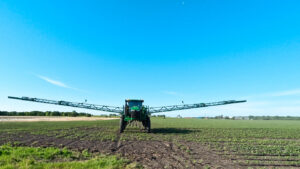Many growers prefer to repurchase existing ag technologies such as auto-steer systems rather than spend money on new ones, according to a new report from Boston Consulting Group (BCG). Agribusinesses must consider factors beyond the size of a farm and its crops in order to entice growers towards adopting the newer technologies, the report concludes.
The report targets a very specific group — agribusinesses with new tech aiming to reach farmers — and is based on a survey of US owners and managers of farms larger than 250 acres mostly producing corn, soy, wheat, or cotton.
That farmers might be reticent to adopt new tech is rather a no-brainer, given the low margins and increasing costs they grapple with.
“Faced with weak agricultural commodity prices and high interest rates, US growers are more inclined than ever to purchase technology solutions that they know and trust, rather than take a chance on something new,” notes BCG.
Or as one agtech startup put it in a recent guest post for AgFunderNews, “Farmers don’t have the time to waste on agtech startups to manufacture machines that take years to deliver and have yet to earn grower’s trust.”
While fairly brief and high level, the BCG report identifies some specific needs behind farmers’ purchasing decisions that agribusinesses should pay attention to when trying to gain traction for a product or service.
What growers will spend money on in 2024
Auto-steer systems, which have existed in agricultural settings for a few decades, was the top technology farmers surveyed said they would repurchase in 2024, followed closely by farm management systems and slow-release inputs.
Precision irrigation systems, autonomous farming equipment, and in-field sensors had the lowest repurchase rates, though this might be due to the relative newness of the technologies and the fact that there are simply fewer of them compared to, say, a tractor.
For newer tech, growers are most likely to purchase precision application systems and biological inputs.
Factors driving agtech adoption
According to BCG, which uses an in-house methodology to identify drivers, agribusinesses normally segment their target customers by farm size, location, or crops.
In contrast, BCG says its survey “reveals that age and whether or not a farm will pass to the children are more telling indicators” of what a farmer is likely to adopt in terms of tech.
The research presents seven different segments into which farmers fit, each based on factors like age or attitude towards sustainable farming practices.
“It’s not enough for companies to know that these segments exist; they need to know which customers fit in which segments to enable stronger go-to-market efforts and, ultimately, better outcomes,” BCG notes.
Increased revenue, reliability, and low operating costs were the top “functional” needs cited; Top “emotional” needs included saving time on busy work, taking care of the soil, and feeling in control.
By contrast, the environmental friendliness of a technology and tax breaks were the lowest-ranked functional needs, while family legacy and a feeling of safety came in last for emotional needs.




